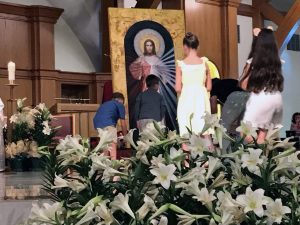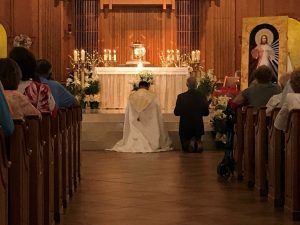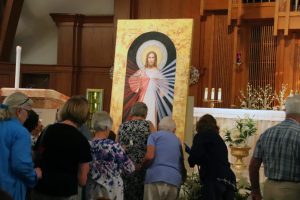Bob Reddy – Florida Catholic
The Second Sunday of Easter, or Divine Mercy Sunday, completes the Octave of Easter, a celebration of the Resurrection of Jesus Christ and the blessing of His continuing presence in our midst. The Gospel reading for Divine Mercy Sunday, April 28, recalls the encounter between St. Thomas and Jesus after the Resurrection.
 For many in the Diocese of Venice, the Feast of Divine Mercy takes on a powerful meaning when they participate in a private or public prayer called the Chaplet of Divine Mercy. Each year many parishes throughout the Diocese hold Divine Mercy services and novenas. The popularity of Divine Mercy has been noticed and embraced by many diverse communities throughout the Diocese.
For many in the Diocese of Venice, the Feast of Divine Mercy takes on a powerful meaning when they participate in a private or public prayer called the Chaplet of Divine Mercy. Each year many parishes throughout the Diocese hold Divine Mercy services and novenas. The popularity of Divine Mercy has been noticed and embraced by many diverse communities throughout the Diocese.
Divine Mercy Sunday celebrates the mercy of Jesus as reminded us by St. Maria Faustina Kowalska, a religious sister who lived a humble life to whom Jesus appeared. St. Faustina was born in Krakow, Poland and lived from 1905-1938 being canonized by St. John Paul II in 2000, who at that time declared the Second Sunday of Easter is Divine Mercy Sunday.
 St. Faustina wrote in her diary what Jesus told her: “I desire that the Feast of Mercy be a refuge and shelter for all souls but especially for poor sinners. I pour out a whole ocean of graces upon these souls who approach the fount of My Mercy… let no soul fear to draw near to Me, even though its sins be many.”
St. Faustina wrote in her diary what Jesus told her: “I desire that the Feast of Mercy be a refuge and shelter for all souls but especially for poor sinners. I pour out a whole ocean of graces upon these souls who approach the fount of My Mercy… let no soul fear to draw near to Me, even though its sins be many.”
The image of the Divine Mercy was created by St. Faustina who was told to paint the image of Jesus as she saw Him. The painting has the saying at the bottom: “Jesus, I Trust in You.” The rays emanating from Jesus represent water – which makes souls righteous — and blood — which is the life of souls, Jesus told St. Faustina.
 At St. William Parish in Naples, Divine Mercy Sunday included the traditional afternoon prayer service. This included Exposition of the Blessed Sacrament, a reflection from Father Anthony Lukka, recitation of the Divine Mercy Litany, singing of the Divine Mercy Chaplet, and concluded with a veneration of the image of Divine Mercy. A large newly-created painting of the Divine Mercy image, by Rosalie Polivika Ramstead, was on display during the prayer service.
At St. William Parish in Naples, Divine Mercy Sunday included the traditional afternoon prayer service. This included Exposition of the Blessed Sacrament, a reflection from Father Anthony Lukka, recitation of the Divine Mercy Litany, singing of the Divine Mercy Chaplet, and concluded with a veneration of the image of Divine Mercy. A large newly-created painting of the Divine Mercy image, by Rosalie Polivika Ramstead, was on display during the prayer service.
The prayer service began with a procession which brought the Divine Mercy image forward while being escorted by the Color Corps of the Knights of Columbus. First children, then adults placed red and white flowers before the image.
Divine Mercy Sunday serves as an important time to remind our brothers and sisters in Christ of our own need to be merciful and that no sin is too great to receive the Lord’s forgiveness, Father Lukka explained.
“Don’t take forgiveness for granted,” he warned. “You must ask for forgiveness, which will help you grow closer to Jesus Christ.”
Georgina Stringer loves the Divine Mercy devotion and takes part in the Novena of Divine Mercy which begins on Good Friday. “It is comforting to know that this devotion exists to allow us all to pray as one as we trust in the Lord to bring mercy upon the world.”
Pope Francis describes the Catholic Church as the “Church of Mercy” and stresses the importance that everyone “be apostles of God’s Mercy.”
From the Vatican on Divine Mercy Sunday, Pope Francis reflected on Christ’s wounds, which he said contain the difficulties and persecutions endured by people who suffer today.
“Touch the wounds of Jesus,” Pope Francis said. “The wounds of Jesus are a treasure from which mercy comes.”





